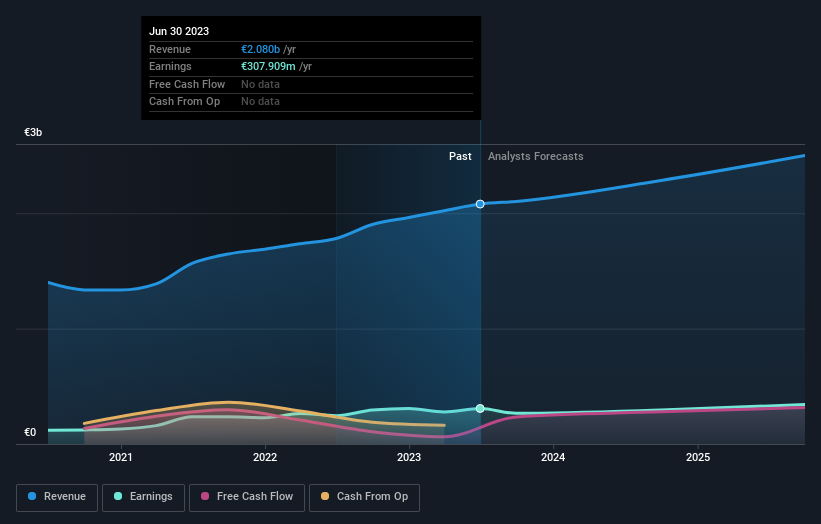Carl Zeiss Meditec AG's (ETR:AFX) 4.0% loss last week hit both individual investors who own 59% as well as institutions
Key Insights
Carl Zeiss Meditec's significant private companies ownership suggests that the key decisions are influenced by shareholders from the larger public
Carl Zeiss Stiftung AG owns 59% of the company
If you want to know who really controls Carl Zeiss Meditec AG (ETR:AFX), then you'll have to look at the makeup of its share registry. We can see that private companies own the lion's share in the company with 59% ownership. In other words, the group stands to gain the most (or lose the most) from their investment into the company.
While the holdings of private companies took a hit after last week’s 4.0% price drop, institutions with their 22% holdings also suffered.
In the chart below, we zoom in on the different ownership groups of Carl Zeiss Meditec.
See our latest analysis for Carl Zeiss Meditec
What Does The Institutional Ownership Tell Us About Carl Zeiss Meditec?
Many institutions measure their performance against an index that approximates the local market. So they usually pay more attention to companies that are included in major indices.
As you can see, institutional investors have a fair amount of stake in Carl Zeiss Meditec. This implies the analysts working for those institutions have looked at the stock and they like it. But just like anyone else, they could be wrong. It is not uncommon to see a big share price drop if two large institutional investors try to sell out of a stock at the same time. So it is worth checking the past earnings trajectory of Carl Zeiss Meditec, (below). Of course, keep in mind that there are other factors to consider, too.
Carl Zeiss Meditec is not owned by hedge funds. Looking at our data, we can see that the largest shareholder is Carl Zeiss Stiftung AG with 59% of shares outstanding. This implies that they have majority interest control of the future of the company. For context, the second largest shareholder holds about 2.9% of the shares outstanding, followed by an ownership of 1.9% by the third-largest shareholder.
While it makes sense to study institutional ownership data for a company, it also makes sense to study analyst sentiments to know which way the wind is blowing. There are a reasonable number of analysts covering the stock, so it might be useful to find out their aggregate view on the future.
Insider Ownership Of Carl Zeiss Meditec
The definition of an insider can differ slightly between different countries, but members of the board of directors always count. Management ultimately answers to the board. However, it is not uncommon for managers to be executive board members, especially if they are a founder or the CEO.
I generally consider insider ownership to be a good thing. However, on some occasions it makes it more difficult for other shareholders to hold the board accountable for decisions.
We note our data does not show any board members holding shares, personally. Not all jurisdictions have the same rules around disclosing insider ownership, and it is possible we have missed something, here. So you can click here learn more about the CEO.
General Public Ownership
The general public, who are usually individual investors, hold a 19% stake in Carl Zeiss Meditec. This size of ownership, while considerable, may not be enough to change company policy if the decision is not in sync with other large shareholders.
Private Company Ownership
We can see that Private Companies own 59%, of the shares on issue. Private companies may be related parties. Sometimes insiders have an interest in a public company through a holding in a private company, rather than in their own capacity as an individual. While it's hard to draw any broad stroke conclusions, it is worth noting as an area for further research.
Next Steps:
It's always worth thinking about the different groups who own shares in a company. But to understand Carl Zeiss Meditec better, we need to consider many other factors.
Many find it useful to take an in depth look at how a company has performed in the past. You can access this detailed graph of past earnings, revenue and cash flow.
If you would prefer discover what analysts are predicting in terms of future growth, do not miss this free report on analyst forecasts.
NB: Figures in this article are calculated using data from the last twelve months, which refer to the 12-month period ending on the last date of the month the financial statement is dated. This may not be consistent with full year annual report figures.
Have feedback on this article? Concerned about the content? Get in touch with us directly. Alternatively, email editorial-team (at) simplywallst.com.
This article by Simply Wall St is general in nature. We provide commentary based on historical data and analyst forecasts only using an unbiased methodology and our articles are not intended to be financial advice. It does not constitute a recommendation to buy or sell any stock, and does not take account of your objectives, or your financial situation. We aim to bring you long-term focused analysis driven by fundamental data. Note that our analysis may not factor in the latest price-sensitive company announcements or qualitative material. Simply Wall St has no position in any stocks mentioned.


